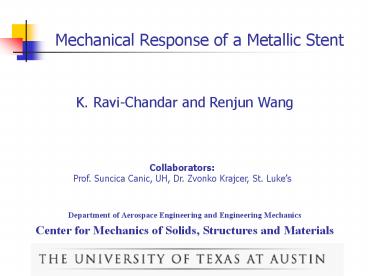Mechanical Response of a Metallic Stent
1 / 36
Title:
Mechanical Response of a Metallic Stent
Description:
Department of Aerospace Engineering and Engineering Mechanics ... AnueRx Bifurcated Stent. WallStent. Villareal, Howell, and Krajcer. Tex Heart Inst J 2000;27:146-9 ... –
Number of Views:59
Avg rating:3.0/5.0
Title: Mechanical Response of a Metallic Stent
1
Mechanical Response of a Metallic Stent
K. Ravi-Chandar and Renjun Wang
Department of Aerospace Engineering and
Engineering Mechanics Center for Mechanics of
Solids, Structures and Materials
Collaborators Prof. Suncica Canic, UH, Dr.
Zvonko Krajcer, St. Lukes
2
Outline
- Stents in vascular applications
- Failure modes
- Mechanics problem
- Experimental characterization
- Analysis of the deformation
- Coupled stent-artery deformation
- Outlook
3
Arteries
J Humphrey, Cardiovascular Solid Mechanics,
Springer, 2002
4
Abdominal Aortic Aneurysm
C.E. Ruiz, et al, Circulation, 1997962438-2448
5
Structural changes in the artery
- Dramatic decrease in elastin and smooth muscle
cell content - Increase in collagen
- Degradation of arterial resistance to the blood
pressure
6
Treatment
- Surgical placement of stent-grafts
- Extensive surgery not all patients are suitable
for this procedure - Endovascular placement of stents and stent-grafts
- Quick, simple procedure currently still
experimental - Long-term consequences are not well characterized
7
AnueRx Bifurcated Stent
8
WallStent
Villareal, Howell, and Krajcer Tex Heart Inst J
200027146-9
9
Abdominal Aortic Aneurysm
Stent-graft Stent
C.E. Ruiz, et al, Circulation, 1995912470-2477
10
Abdominal Aortic Aneurysm
- Short term
- Reduction in the size of aneurysm
- Long term
- Dilation of proximal side of artery
- Wever et al., (2000), European Journal of
Vascular and Endovascular Surgery, 19 197201. - Endoleaks
- Chuter et al. (2001), Journal of Vascular
Surgery, 34, 98105. - Migration and other forms of failure
- Shames, Sanchez, Rubin and Sicard, (2002)
Vascular and Endovascular Surgery, 36, 77-83 - Bell (2002), Editorial, Vascular Medicine 7,
253255
11
Our Objectives
- Evaluate the mechanical response of the stent in
appropriate configurations Experimental - Develop the appropriate structural mechanics
description - Analytical - Evaluate the coupled response of the stent and
the blood vessel - Analytical
12
Experimental apparatus
External Pressure
Internal Pressure
13
Pressure-diameter relationship
Normal range of the aorta
14
Pressure-length relationship
15
Helical spring model Kirchhoff-Love theory
r0, a0 initial radius and pitch angle r, a
radius and pitch angle Pa axial force Ps
transverse shear force MB bending moment Mt
twisting moment q effect of pressure loading on
the wire Fz external axial force
16
Equilibrium equations
(1)
(2)
(3)
17
Pressure loading
The internal pressure loading is distributed
uniformly over the n wires, resulting in the load
distribution q
18
Curvature and twist evolution
Curvature
Twist
Bernoulli-Euler Beam Theory
(4)
Coulomb Torsion Theory
(5)
19
Geometrical constraint
The braiding of the n wires results in contact at
the cross-over points these are constrained
frictionally and therefore the wire is not
allowed to unwind helically as the stent expands.
This can be expressed as a constraint between the
radius and the pitch angle of the helix
(6)
20
Pressure-diameter relationship
This is an exact relationship within the
restrictions of the Kirchhoff-Love slender rod
theory, without any adjustable parameters.
21
Parameters of the stent
n Number of wires 36 E Modulus of
elasticity 200 GPa G Shear modulus 77
GPa a Radius of the stent wire 0.170
mm a0 Pitch angle of the helix at zero
pressure 34? r0 Radius of the stent at zero
pressure 0.01 m L Length of the stent 0.08 m
22
Effect of friction
Friction acts on the cylindrical surface of the
stent in the axial direction, and is given by
23
Pressure-diameter relationship
24
Pressure-length relationship
25
Axial force measurements
26
Axial force measurement
27
Spatially varying pressure A
beam-on-elastic-foundation model
f(r)
28
Governing differential equation
Fixed boundary
Free boundary
Compliant boundary
29
Example 1 Fixed ends
30
Comparison to experiments
31
Example 2 stent exiting a catheter
32
Coupled response of the aorta and stent
33
Response of the aorta
Curve fit to data from Länne T et al 1992,
Noninvasive measurement of diameter changes in
the distal abdominal aorta in man, Ultrasound in
Med Biol,18451-457.
34
Coupled response - results
35
Summary
- Experimental methods developed to evaluate the
mechanical response of stents - Analytical models were developed to characterize
the response of the stent by itself and coupled
with the aorta - The procedures established should enable design
of AAA stents - Prof Canic is working on embedding these models
with fluid flow simulations
36
Dilation of the aorta
Source Wever et al., (2000), European Journal of
Vascular and Endovascular Surgery, 19 197201.































